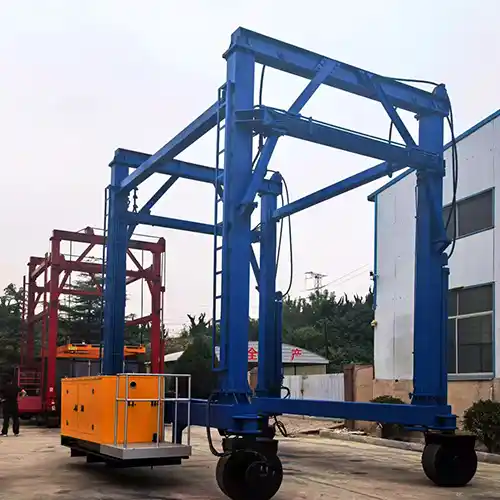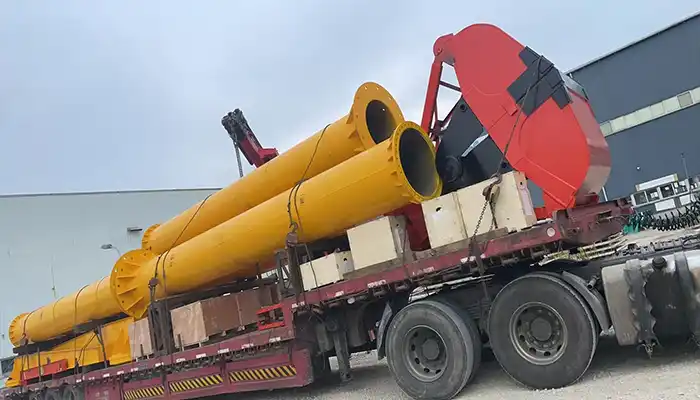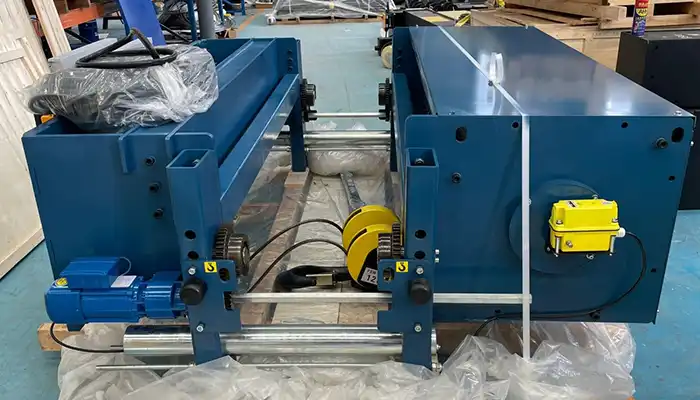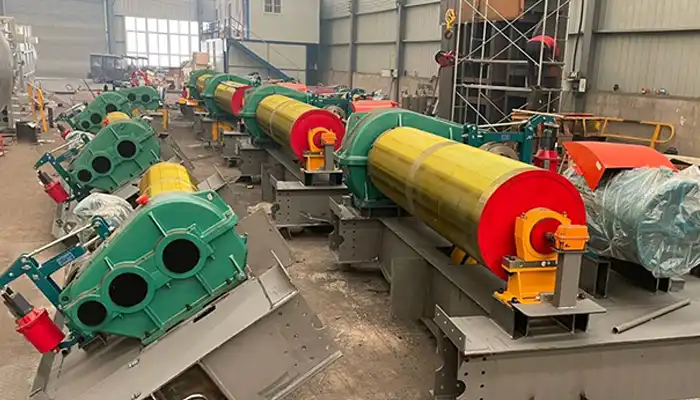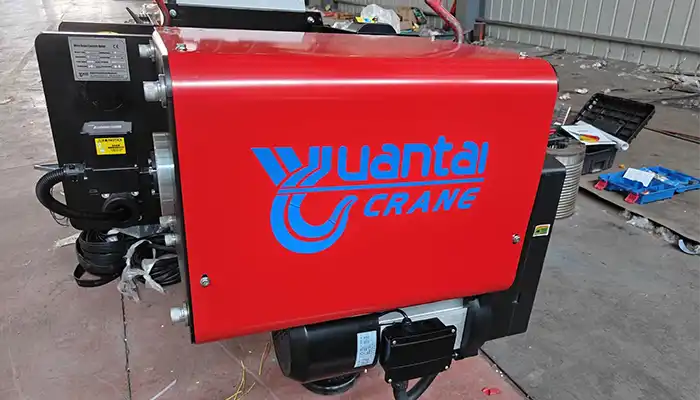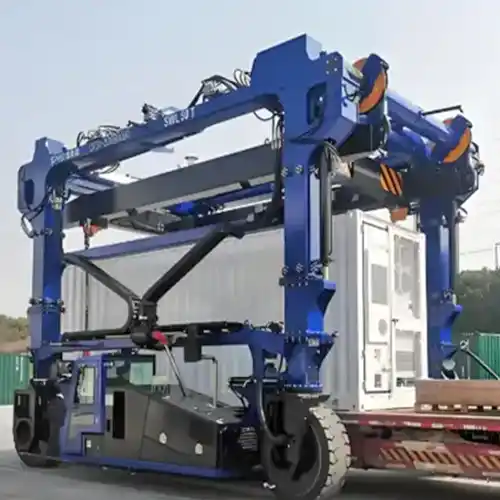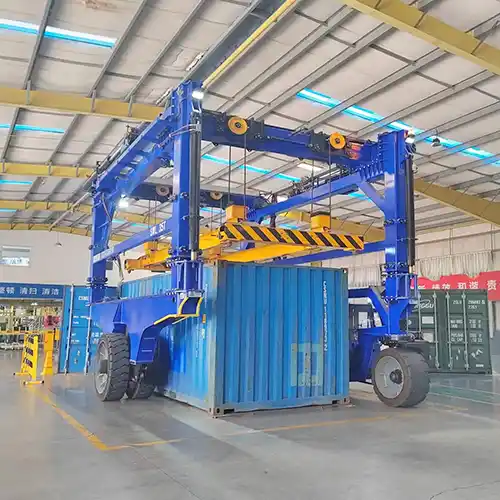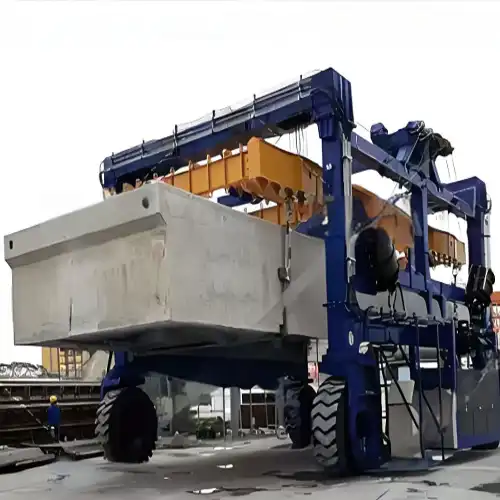Straddle Carrier Troubleshooting: Key Steps for Buyers
Essential troubleshooting steps for 60-ton straddle carriers, addressing common issues and ensuring smooth, efficient operation during heavy lifting.
Category: Featured
Your Trusted Overhead Crane Manufacturer & Supplier
Straddle Carrier Troubleshooting: Key Steps for Buyers
What to Do When Something Goes Wrong with Your Industrial Straddle Carrier
Straddle Carrier Troubleshooting Overview
Straddle carriers are key machines in heavy lifting, often used in container handling at ports and warehouses. They are complex pieces of equipment, requiring proper care to maintain their performance. Regular troubleshooting helps prevent disruptions in operations, reduces downtime, and minimizes costly repairs.
Typical issues include hydraulic leaks, engine malfunctions, and tire wear. If left unchecked, these issues can significantly impact the carrier's operational efficiency, potentially causing delays in high-demand environments.
Why Troubleshooting Matters
Minimizing Downtime
Identifying and fixing problems early means less downtime, which is crucial in high-volume operations. A malfunction in a straddle carrier can halt operations, leading to delays in container movement. Effective troubleshooting ensures the carrier remains operational, maintaining the flow of work.
Reducing Repair Costs
Proactive troubleshooting prevents minor issues from escalating into expensive repairs. For instance, spotting a hydraulic leak early can stop further damage, avoiding costly fixes later. Regular diagnostics help prolong the carrier’s lifespan, ensuring it remains a valuable asset for years to come.
In summary, troubleshooting isn't just about fixing problems as they arise—it’s about keeping operations efficient, reducing unexpected repair costs, and extending the lifespan of the equipment.
Common Problems in Straddle Carriers
Hydraulic Leaks
Hydraulic Issues
Straddle carriers rely on a hydraulic system for lifting, steering, and load management. Common hydraulic problems include low fluid levels, leaks in hoses or fittings, and pump failure. These issues can compromise the carrier’s performance, affecting lifting capabilities and overall efficiency.
Causes and Signs
- Low Fluid: Over time, hydraulic fluid can leak, reducing pressure in the system. Check fluid levels regularly.
- Leaks: Leaks often occur at the hydraulic hoses, seals, or fittings. They can cause a loss of power and increase fluid consumption.
- Pump Failure: Overheating or contamination can damage the hydraulic pump, leading to inefficient operation or complete failure.
Signs of hydraulic problems include slow lifting speeds, erratic movements, or an increase in the time it takes to raise or lower loads.
Engine Malfunctions
Typical Engine Problems
The engine is the powerhouse of the straddle carrier, and without it functioning well, the carrier’s performance suffers. Common issues involve overheating, fuel delivery problems, or electrical failures.
- Overheating: Caused by a lack of coolant, poor airflow, or excessive load. Overheating can lead to engine damage and loss of power.
- Fuel Issues: Contaminated fuel or clogged fuel filters can reduce engine performance and cause stalling.
- Electrical Failures: Issues such as battery failure, faulty wiring, or alternator problems can prevent the engine from starting or running efficiently.
Symptoms to Watch For
- Engine warning lights on the dashboard
- Unusual sounds or vibrations from the engine
- Reduced power, stalling, or difficulty starting the engine
Tire Wear and Damage
Common Tire Issues
Tires are essential for the mobility of the straddle carrier. Improper tire care can lead to costly downtime and unsafe operations. Common tire problems include uneven wear, punctures, and flat tires.
Causes of Tire Damage
- Uneven Wear: Caused by improper load distribution, incorrect tire pressure, or poor alignment. This accelerates tire wear, reducing lifespan and compromising safety.
- Punctures: Sharp objects or debris on the ground can puncture the tires, leading to slow leaks or sudden blowouts.
- Flat Tires: Can be caused by damage from impacts, low air pressure, or wear and tear over time.
How to Address Tire Issues
- Regularly check tire pressure and ensure it’s within the manufacturer’s recommended range.
- Inspect tires for signs of uneven wear, cracks, or punctures and replace them when necessary.
- Rotate tires regularly to ensure even wear and extend tire life.
The three most common problems in straddle carriers—hydraulic leaks, engine malfunctions, and tire wear—are crucial to monitor. Identifying these issues early can prevent operational disruptions, reduce repair costs, and keep the carrier running efficiently. Regular maintenance and troubleshooting help address these problems before they escalate, ensuring smooth operations.
Step-by-Step Troubleshooting Guide
Hydraulic Leaks
How to Check for Leaks and Identify the Source
- Visual Inspection: Begin by visually inspecting all hydraulic hoses, connections, and seals for visible signs of leaks, oil stains, or wear.
- Check Hydraulic Fluid Levels: Low fluid levels are often a clear indicator of leaks. Make sure to check the reservoir and refill if necessary.
- Pressure Testing: Perform a pressure test to ensure the hydraulic system is maintaining the appropriate pressure. A drop in pressure can indicate a leak in the system.
- Leak Detection: Use a leak detection dye or spray to help pinpoint small leaks that are difficult to see. These products can help reveal leaks in hard-to-access areas.
Solutions for Fixing Common Hydraulic Issues
- Fluid Replacement: If the fluid is contaminated or low, replace it with the recommended hydraulic fluid.
- Sealing Leaks: Tighten or replace any loose or damaged fittings, hoses, or seals. If a leak is present in a hose, replace the hose entirely. Always ensure that the replacement parts are compatible with the hydraulic system.
- Pump Maintenance: If the pump is faulty, consider cleaning the pump or replacing it if necessary. Regularly check for contamination in the hydraulic oil to prevent further damage.
Engine Malfunctions
Diagnostic Steps for Engine Problems
- Check Fluid Levels: Start by inspecting the engine oil, coolant, and fuel levels. Low fluid levels can often cause overheating or poor engine performance.
- Inspect Air Filters and Sensors: Clogged air filters or malfunctioning sensors can impact engine performance. Clean or replace the filters if needed and check sensor wiring for any faults.
- Inspect Wiring and Connections: Check all electrical connections, ensuring they are tight and free from corrosion. Faulty wiring or a loose connection can prevent the engine from starting or running efficiently.
- Check Fuel System: Inspect the fuel system for blockages, and ensure that the fuel lines, filters, and injectors are clean. Any sign of contamination could affect the fuel delivery.
Solutions for Addressing Engine Problems
- Overheating: If overheating is an issue, check the coolant levels and ensure the radiator or cooling system is functioning properly. Clean any obstructions around the radiator that might block airflow.
- Fuel System Problems: Replace fuel filters, clean fuel injectors, and make sure the fuel lines are free of debris. If contamination is suspected, flush the fuel system and replace any affected components.
- Electrical Failures: For electrical issues, replace the battery if it’s weak, and check the alternator for any faults. Ensure all electrical components are functioning correctly by testing circuits with a multimeter.
Tire Wear
How to Inspect Tires for Wear and Damage
- Check Tire Pressure: Regularly monitor the tire pressure to ensure it is within the manufacturer’s recommended range. Low pressure can cause uneven wear and tire damage.
- Visual Inspection: Look for cracks, punctures, or cuts in the tire tread. Check for uneven wear patterns, which may indicate misalignment or improper load distribution.
- Tread Depth: Use a depth gauge to measure the tire tread. If the tread is too shallow or worn unevenly, it’s time to replace the tires.
- Look for Sidewall Damage: Inspect the sidewalls for any bulges or cuts. These can indicate internal damage, which may compromise the tire’s safety.
Solutions for Tire Issues
- Balancing: If the tire shows signs of uneven wear, consider balancing it. This helps distribute the weight evenly and extends the tire’s lifespan.
- Proper Inflation: Always ensure tires are inflated to the correct pressure as per the manufacturer’s specifications. Under or over-inflated tires can wear unevenly and lead to faster deterioration.
- Tire Replacement: If a tire has visible damage, excessive wear, or is no longer performing efficiently, replace it with a new one. Regular tire rotation can also help in achieving even wear.
- Preventive Maintenance: Perform regular tire checks and rotate the tires periodically to maintain balanced wear. Ensure proper load distribution during operation to prevent premature damage.
By following these troubleshooting steps for hydraulic leaks, engine malfunctions, and tire wear, operators can effectively identify and resolve common issues with 60-ton straddle carriers. Regular monitoring and maintenance not only reduce operational downtime but also prolong the lifespan of the equipment. Proper troubleshooting ensures safe and efficient performance, preventing minor issues from escalating into costly repairs.
Preventive Measures to Avoid Issues
Hydraulic System Maintenance
Tips for Maintaining the Hydraulic System to Prevent Leaks
- Regular Fluid Checks: Regularly check the hydraulic fluid levels to ensure they are within the recommended range. Low fluid levels can lead to damage to the hydraulic components.
- Replace Seals and Hoses: Inspect seals, hoses, and connections for wear or damage. Replace any parts that show signs of cracking or leakage. Seals can wear out over time, and replacing them proactively prevents potential leaks.
- Clean the System: Keep the hydraulic system clean by ensuring that no contaminants enter the fluid reservoir. Contaminants can clog filters and lead to component failure.
- Monitor Pressure: Regularly check system pressure to make sure it remains within optimal limits. Excessive pressure can cause damage to components like pumps or cylinders.
- Schedule Fluid Replacement: Over time, hydraulic fluid can degrade, leading to poor performance and potential leaks. Change the fluid at regular intervals as recommended by the manufacturer.
Engine Care
Steps for Ensuring Optimal Engine Performance
- Regular Inspections: Inspect the engine on a regular basis for any signs of wear or damage. This includes checking fluid levels, hoses, and belts.
- Address Minor Issues Early: If you notice small issues such as unusual noises, warning lights, or slight changes in performance, address them promptly. Small issues, when left unchecked, can lead to bigger problems down the road.
- Oil Changes: Regularly change the engine oil to ensure it remains clean and effective in lubricating the engine. Dirty oil can lead to overheating and increased wear.
- Check Filters: Clean or replace the air, fuel, and oil filters to ensure they are not clogged. A clogged filter reduces engine efficiency and can cause unnecessary strain on the engine.
- Battery Maintenance: Inspect the battery regularly for any signs of corrosion. Clean the terminals and check the battery charge to avoid sudden power failures.
Tire Maintenance
Regular Tire Checks, Proper Inflation, and Alignment
- Inspect Tires Frequently: Check for signs of wear, cracks, punctures, or other damage. Regular visual inspections can help you catch problems early before they lead to a flat tire or blowout.
- Maintain Proper Tire Inflation: Ensure that all tires are inflated to the correct pressure as specified by the manufacturer. Incorrect tire pressure can cause uneven wear, decreased fuel efficiency, and poor handling.
- Align Tires Properly: Misaligned tires lead to uneven wear and increased stress on certain parts of the tire. Ensure that the wheels are aligned correctly during each inspection.
- Rotate Tires: Regularly rotate the tires to promote even wear. This can extend the life of the tires and ensure better overall performance.
- Balance Tires: Ensure that the tires are properly balanced to avoid vibrations and uneven wear. Unbalanced tires can also put extra strain on the suspension system.
Preventive maintenance is crucial for the long-term performance and efficiency of a 60-ton container straddle carrier. By regularly maintaining the hydraulic system, engine, and tires, you can avoid costly breakdowns, minimize downtime, and extend the lifespan of the equipment. Proactive care helps in identifying and fixing small issues before they become major problems, ensuring safe and reliable operations.
When to Call a Professional
Signs You Need Professional Help
While regular troubleshooting and maintenance can resolve many minor issues, certain situations require professional expertise. Recognizing when to call for help is crucial to avoid worsening the problem and to ensure the safety and longevity of the straddle carrier.
- Persistent or Unresolved Problems: If issues like hydraulic leaks, engine overheating, or tire damage persist even after troubleshooting, it's time to reach out to a professional. These problems might indicate deeper mechanical issues that require specialized knowledge.
- Complex Hydraulic Failures: Hydraulic systems are intricate and require precision in diagnosis. If you’re dealing with pump failure, valve issues, or low fluid that doesn’t resolve with simple fixes, an expert should inspect and repair the system.
- Engine Diagnostics: Engine malfunctions, such as inconsistent performance, abnormal noises, or fuel inefficiency, might need advanced diagnostic tools that only professionals have. If you’ve checked the obvious causes (oil levels, air filters, etc.) and the problem persists, a mechanic with the right expertise should be called in.
- Electrical Issues: If your straddle carrier is experiencing electrical failures (such as battery drain, sensor issues, or wiring problems), the issue may be complex. These systems often require expert knowledge and equipment for accurate diagnosis and repair.
- Major Structural Damage: Sometimes, the straddle carrier may experience frame or structural damage, such as cracks or bends, especially after heavy use or impacts. If the structural integrity of the carrier is compromised, it’s important to have professionals assess and repair it to prevent further complications or accidents.
Contacting a Professional
In some cases, professional assistance isn’t just necessary for safety—it can also prevent the escalation of issues that could be expensive to fix later. Here’s when to consider professional help:
- Engine Diagnostics: If the engine is malfunctioning in ways that affect its power, fuel efficiency, or starting performance, an expert can use specialized diagnostic tools to pinpoint issues like sensor failures, fuel system problems, or complex internal engine faults.
- Hydraulic System Repairs: Hydraulic systems are critical for lifting and maneuvering heavy loads. If the issue is deep within the system, like valve malfunctions, pump failure, or fluid contamination, contacting a hydraulics expert is essential for a safe, effective fix.
- Safety Concerns: If a straddle carrier is operating unsafely, for instance, when sensors, brakes, or overload protection mechanisms fail, a professional should be contacted immediately. Continuing operations without addressing these concerns can pose significant risks.
Knowing when to involve a professional can save time, money, and prevent accidents. While simple maintenance and troubleshooting can resolve many issues, more complex problems, particularly in the engine, hydraulic system, or electrical systems, require professional expertise. Keeping the equipment in optimal condition and ensuring the safety of operations means recognizing the limitations of DIY repairs and getting professional help when necessary.
Conclusion
Importance of Timely Troubleshooting
Timely troubleshooting plays a crucial role in maintaining the efficiency of a 60-ton straddle carrier. Addressing problems as they arise prevents small issues from escalating into larger, more costly ones.
- Reduces downtime
- Helps extend equipment lifespan
- Minimizes disruptions in operations
Prompt action ensures that the carrier remains operational and reduces the need for expensive repairs in the future.
Ongoing Maintenance and Monitoring
Regular maintenance and monitoring are essential to keep a straddle carrier in optimal condition. Routine inspections can help identify potential issues before they cause significant problems.
- Regularly check hydraulic systems, tires, and engine performance
- Follow proper lubrication schedules and ensure tire inflation
- Perform routine fluid replacements and inspections
By staying on top of maintenance, operators can reduce the likelihood of needing urgent troubleshooting, improving the reliability of the equipment and minimizing unexpected downtime.
Main Projects
Related Products
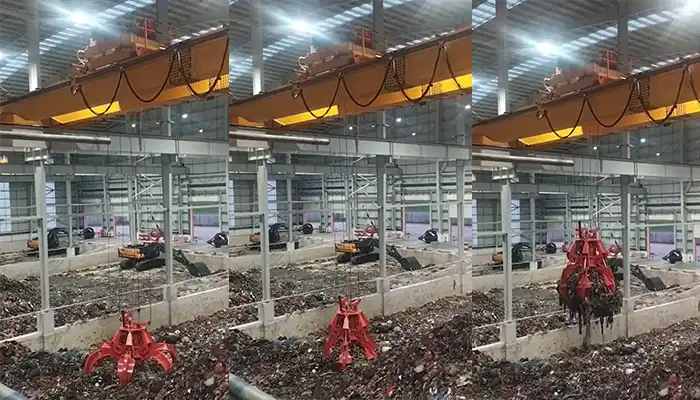
Supplied three grab bucket crane kits to Indonesia, enhancing garbage handling efficiency with high load capacity and reliable performance.
Free consultation to Confirm Parameters & Specifications and Get
Latest Crane Price & Crane Rate.
- Types of overhead cranes : _______?
- Optional: Overhead travelling crane, goliath gantry crane,Slewing jib crane, Single girder or double girder crane,small portable crane or kbk crane, etc.
- Capacity of overhead crane: _______?
- Optional: 0.25ton, 0.5 ton, 1 ton, 2 ton, 3ton, 5 ton, 10 ton,15ton, 20ton, 25 ton, 30ton,35ton, up to 550ton, etc.
- Crane span & lifting height : _______?
- Crane travelling length : _____?
- Control of overhead crane:_______?
- Optional: pendant/ remote/cabin control
- Voltage supply of overhead crane:_____?
- Eg,: 380V50/60HZ,3Phase or others,etc.
- Application/usage of crane:_______?
- Eg,: Steel mill, ,injection mold, cement,stone, concrete,granite, general manufacturing, etc.
Just leave a message via the contact form and our hoist and crane engineer will contact you with in 24working hours.
Get In Touch
